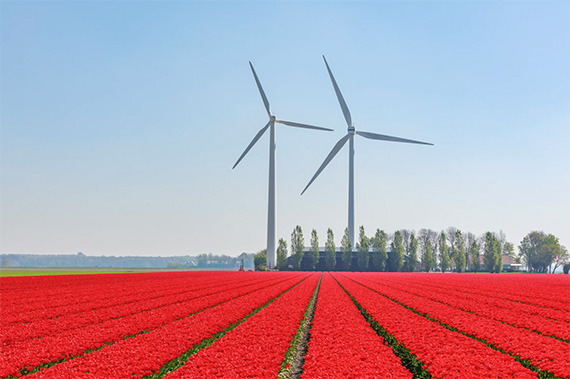December 11, 2019 represents a European milestone in the fight against the destruction of the environment. The European Commission presented a comprehensive plan to curb the advance of climate change. The plan includes various interconnected areas of activity complemented by ambitious objectives, for example the goal of a climate neutral Europe by 2050.
The European Green Deal provides the tools the European Union needs to meet the commitments assumed under the Paris Agreement, which went into force on November 4, 2016 and was signed by 55 countries. The principal objective of the agreement is to avoid a 2ºC increase from preindustrial temperatures and to promote additional measures that make it possible to hold global warming to below a 1.5ºC increase.
The European Green Deal Roadmap
During the first months of 2020 after the introduction of the European Green Deal, a torrent of plans and agreements followed in order to encourage the fulfillment of its goals. They included measures targeting different areas:
- The European Green Deal Investment Plan and Just Transition Mechanism: The objective of this policy is to establish support systems for those European regions where the transition to climate-neutrality represents greater effort due to a greater dependency on fossil fuels. It is based on three aspects: (a) financing – to secure a minimum of a billion euros over the next ten years for sustainable investments; (b) enabling – to create incentives to unlock and redirect investment by public and private entities toward sustainable financing; and finally (c) practical support – to assist authorities with the planning, design, and implementation of sustainable projects.
- The European Climate Law: This law establishes the legal framework that will lead to climate neutrality by 2050, making the objective legally binding. It establishes a process of periodic reviews in order to verify progress and make modifications as necessary, reviewing the reported progress every five years against what has been defined in the Paris Agreement. It also lays down the necessary steps for meeting the 2050 target, establishing deadlines for specific milestones. Finally, it summarizes the European Commission’s authority to make recommendations to member states for the fulfillment of the target. Member states are obliged to follow EC recommendations or provide justifiable rationale for not doing so.

- The European Industrial Strategy: This plan lays out how European industry and the EU business community can be competitive within the context of the green transition. The plan lays out three drivers for industrial transformation: the green transition, the digital transition, and competitive viability on the world stage. It defines a two-prong objective for industry: climate neutrality and technological leadership. The plan includes the major players from Europe’s industrial ecosystems: large business, SMEs, supplier service providers, governments, and academic and research institutions.
- The Circular Economy Action Plan: This plan introduces initiatives meant to transform the economy in such a way that it encourages the production of sustainable products that last longer and are easier to reuse and recycle. Some of these initiatives include eco-design and business development that promotes recycling and the reuse of textiles, the elimination of disposable products whenever possible, and the elimination or reduction of non-green product packaging.
- Farm to Fork Strategy: The EU Farm to Fork plan focuses on agriculture and the creation of a more sustainable and healthy food system. The plan includes points aimed at reducing the use of polluting pesticides, the reduction of nutrients and fertilizers that negatively impact biodiversity, and the cultivation of organic farm products in the European Union, with the goal that they will represent 25 percent of European agriculture by 2030.
- EU Biodiversity Strategy for 2030: This agreement will establish protected areas for at least 30 percent of Europe’s land and and 30 percent of its seas in order to restore ecosystems that have been damaged or are endangered, with legally binding targets for 2021. Some of the tactics proposed to curb the destruction of these regions include increased organic farming, decreased use of pesticides, the restoration of 25,000 kilometers of free-flowing rivers, and the planting of 3 billion trees by 2030.
A green recovery
As the coronavirus pandemic has spread across Europe and with the ensuing economic recession, questions have been raised whether it will be possible to sustain the Green Deal’s ambitious agenda. The fight against the climate crisis calls for significant resources, and with the current situation following the COVID-19 onslaught, these resources will be even scarcer and in more demand.

Nonetheless, on April 21st, European Commission Executive Vice President Frans Timmermans, rejected changes to the European Climate Law calendar, and on July 3rd the European Commission issued a request for proposals for what is called the Innovation Fund, a program that promotes technologies that are low in carbon emissions. In Timmermans’ words, Europe’s investment in these innovative projects will help kick start the European Union economy with a green recovery that will move it closer to 2050’s planned climate neutrality.
Similarly, in April the International Monetary Fund published a note underscoring the potential impact the world’s response to COVID-19 could have on climate change. The paper maintained that “policy measures that are taken now will have long-lasting effects on the global economy and will shape societies for decades to come. This in turn will affect emissions and climate.”
Horizon COP26
The UN Climate Change Conference that was planned to be held in Glasgow in November 2020 had to be postponed to 2021 as a consequence of the COVID-19 pandemic.
Faced with this delay, Frans Timmermans announced that the European Union would not slow down its activities. Rather it is moving forward as anticipated to present a plan in September to reduce greenhouse emissions by 50 or 55 percent by 2030.
Comments on this publication